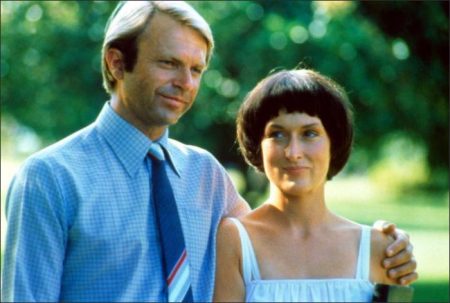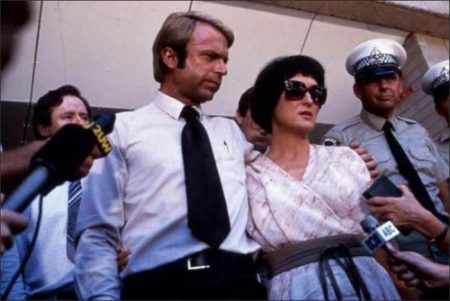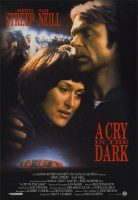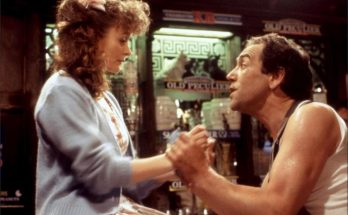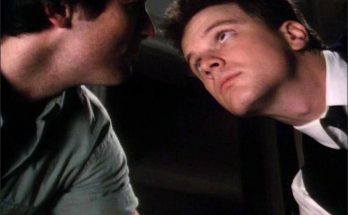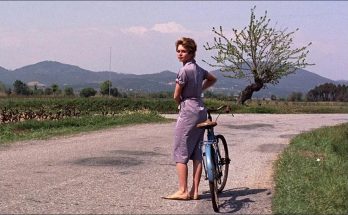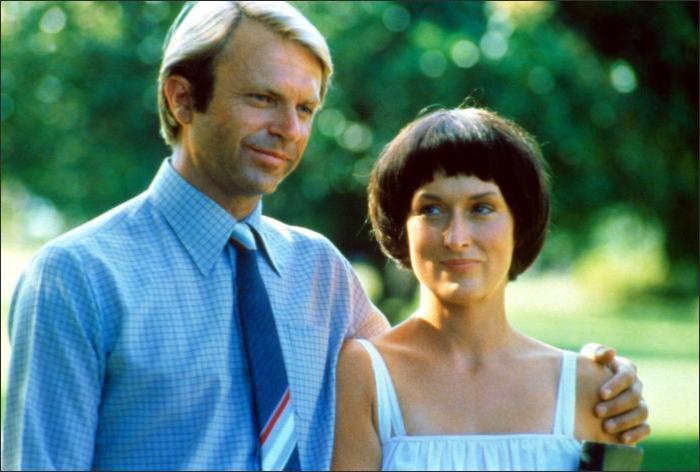Taglines: A family torn apart. A public filled with outrage. A woman accused of murder.
A Cry in the Dark movie synopsis. Based on the true story of Lindy Chamberlain. During a camping trip to Ayers Rock in outback Australia, she claimed that she witnessed a dingo stealing her baby daughter, Azaria, from the family tent. Azaria’s body was never found. Police noted some apparent inconsistencies in her story, and she was charged with murder. The case attracted a lot of attention, turning an investigation into a media circus, with the public divided in their opinions.
Evil Angels (released as A Cry in the Dark outside of Australia and New Zealand) is a 1988 Australian drama film directed by Fred Schepisi. The screenplay by Schepisi and Robert Caswell is based on John Bryson’s 1985 book of the same name. It chronicles the case of Azaria Chamberlain, a nine-week-old baby girl who disappeared from a campground near Uluru (then called Ayers Rock) in August 1980 and the struggle of her parents, Michael and Lindy, to prove their innocence to a public convinced that they were complicit in her death. Meryl Streep and Sam Neill star as the Chamberlains, and Streep was nominated for an Academy Award for her performance. The film was released less than two months after the Chamberlains were exonerated by the Northern Territory Court of Appeals of all charges filed against them.
Film Review for A Cry in the Dark – Evil Angels
Fred Schepisi’s ”Cry in the Dark” is based on the sort of true story beloved by supermarket tabloids that feature headlines about mothers who boil their babies for breakfast.
In 1980, while on a camping trip in the Australian outback with her parents, 5-week-old Azaria Chamberlain disappeared from the tent while her mother, Lindy Chamberlain, and her father, Michael Chamberlain, a Seventh-Day Adventist minister, were sharing a cookout with friends a few feet away.
Lindy Chamberlain had seen a dingo, the Australian coyote-like wild dog, slipping out of the family’s tent and immediately sounded the alarm. In the search that followed, the child’s bloody nightdress was found, but not the body. The local coroner ruled that the evidence suggested the baby had been abducted by the animal and probably killed.
The case didn’t end there, however. On the basis of forensic evidence that later proved extremely faulty, the case was reopened and, as a result, Lindy Chamberlain was tried for the murder of her baby and her husband as an accessory after the fact.
Helping to whip up the hysteria were newspaper and television reporters. The parents were faulted for not having seemed more distraught immediately after the baby disappeared. The public wanted more tears, more visible signs of grief and torment. The Chamberlains were noticeably ”different,” possibly because they belonged to what the reporters referred to as a ”cult.” There were even suggestions the baby had been the victim of a ritual sacrifice.
”A Cry in the Dark,” which opens today at the Coronet and other theaters, has much of the manner of a television docudrama, ultimately being a rather comforting celebration of personal triumph over travails so dread and so particular that they have no truly disturbing, larger application.
Yet ”A Cry in the Dark” is better than that, mostly because of another stunning performance by Meryl Streep, who plays Lindy Chamberlain with the kind of virtuosity that seems to redefine the possibilities of screen acting. If there have been times when Miss Streep’s extraordinary work has looked to be too technical, as in the screen version of ”Plenty,” also directed by Mr. Schepisi, it is because the material (windy and impossibly pretentious in ”Plenty”) has left her apparently performing in a vacuum.
The screenplay for ”A Cry in the Dark,” adapted by Robert Caswell and Mr. Schepisi from a book by John Bryson, isn’t perfect, but it provides Miss Streep with the kind of raw material that allows her to create a character who, while being perfectly ordinary, is always unexpectedly special.
Wearing what appears to be a not-great black wig, which fits her head like a shower cap, and speaking with a New Zealand accent overlaid with a strong layer of Australian, Miss Streep’s Lindy Chamberlain is just reticent and stubborn enough to deflect easy sentimentality. There also seems to be something a little arrogant about her, which is the way most of us react to people with strongly held beliefs we don’t share.
There is wit, which is not to be confused with humor, in everything she does, from the remarkable accent to the physical mannerisms. Unlike most screen actresses, Miss Streep works on two levels at once. There is, on the surface, the character she is creating within the context of the script. Underneath that, there is the sometimes breathtaking pleasure in watching an actress exercise her talent as she reaches for, and achieves, the high notes.
This is not an especially popular form of screen acting. It has the effect of calling attention to itself, which goes against the grain of realist cinema in which verisimilitude is all. Being able to see and to enjoy an actress act, much as one attends to a diva such as Joan Sutherland, is not something moviegoers take to – unless, like Bette Davis, the actress more or less announces what she’s doing with gestures that have become familiar with time.
Miss Streep is an original for our own era. Though Sam Neill is very good as Lindy Chamberlain’s tormented husband, Miss Streep supplies the guts of the melodrama that are missing from the screenplay. Mr. Schepisi has chosen to present the terrible events in the outback in such a way that there’s never any doubt in the audience’s mind about what happened. The audience doesn’t worry about the fate of the Chamberlains as much as it worries about the unconvincing ease with which justice is miscarried.
Mr. Schepisi may have followed the facts of the case, but he has not made them comprehensible in terms of the film. The manner by which justice miscarries is the real subject of the movie. In this screenplay, however, it serves only as a pretext for a personal drama that remains chilly and distant.
While watching the film, suspense wars with impatience. As a result, the courtroom confrontations are so weakened that ”A Cry in the Dark” becomes virtually a one-character movie. It’s Mr. Schepisi’s great good fortune that that one character is portrayed by the incomparable Meryl Streep.
A Cry in the Dark – Evil Angels (1988)
Directed by: Fred Schepisi
Starring: Meryl Streep, Sam Neill, Dale Reeves, David Hoflin, Jason Reason, Michael Wetter, Lauren Shepherd, Bethany Ann Prickett, Aliza Dason, Jane Coker, Nicolette Minster
Screenplay by: Robert Caswell, Fred Schepisi
Production Design by: Wendy Dickson, George Liddle
Cinematography by: Ian Baker
Film Editing by: Jill Bilcock
Costume Design by: Bruce Finlayson
Art Direction by: Dale Duguid, Brian Edmonds
Music by: Bruce Smeaton
Distributed by: Warner Bros. Pictures (United States), Cannon Films (International)
Release Date: November 11, 1988
Views: 161
